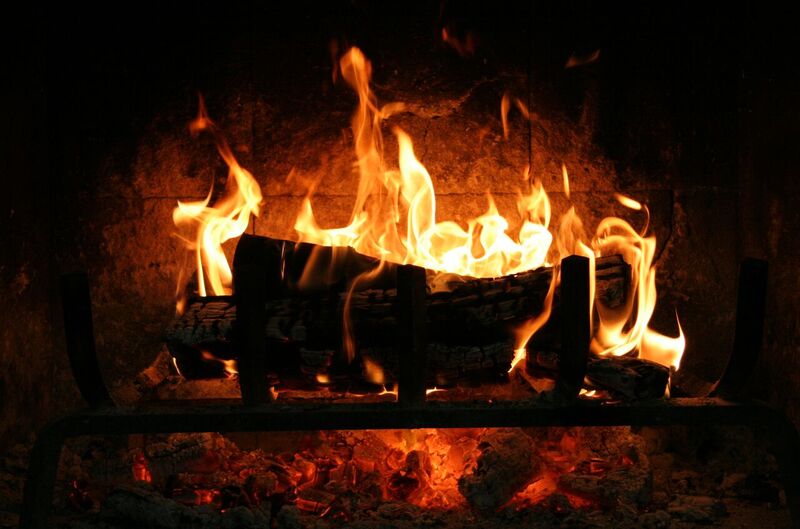
Trees. I seem to write about polarizing topics. Not intentionally. Maybe I just see both sides of the issue; or in this case, the hot and cold of the issue.
First, I want to talk fire, Scarecrow. As in firewood. ‘Tis the season to enjoy a hot toddy by the fire or you might even heat your entire home with wood. I’m more of the hot toddy kind of girl, so let’s talk wood-burning fireplaces.
You may have been advised to purchase seasoned firewood. What exactly does that mean? All firewood contains water. Freshly cut wood can be as much as 45% water. If you allow the wood to “season” it will reduce that moisture percentage to approximately 20-25%.
Wood is composed of bundles of microscopic tubes that are used to deliver water from the roots of a tree to its leaves. These tubes stay saturated for years, even after a tree is dead. This is why it is important to either cut your firewood or purchase wood that has been cut to length for six months or more. Splitting the wood also helps the drying process by exposing more of the wood to the sun and wind or in other words, it is seasoned.
If you are going to purchase wood, firewood is generally sold by volume. The most common measure is called a cord. A standard cord of firewood is 128 cubic feet. This basically means the pile of wood should measure 8’ long by 4’ tall by 4’ deep.
This should not be confused with a face cord. A face cord is also 8’ long by 4’ tall, but the biggest difference is a face cord is only as deep as the wood is cut. Be diligent in determining the measurement before purchasing.
Once you are sure you are buying the correct amount of wood, check to see if it appears to be seasoned. One of the easiest visual ways to determine if wood has had time to dry is to inspect the ends of the logs. Well-seasoned firewood will generally have darkened ends with cracks and splits and feel relatively light.
A few extra minutes inspecting your firewood before purchasing is time well spent. Quality, well-seasoned firewood will burn cleaner and more efficiently. Green or wet wood can cause smoking problems, odor problems, creosote buildup and possibly even chimney fires.
So, let’s get fired up and snuggle up. And while we’re snuggled up on the couch, watch the birds outside. Brrr! Imagine those little creatures out there searching for food.
I have fed birds for 40-plus years. I wouldn’t say that makes me an expert at bird-feeding or even bird-watching. It does (and has) brought me an unbelievable amount of joy during the cold, dark, winter days of Ohio. The most common birds I have had frequent my feeders during the winter are Chickadees, Titmice, Nuthatches, Creepers and Woodpeckers. These types of birds are known as tree-dwelling birds, or if you want to throw out the technical term, arboreal birds.

All of these birds will eat sunflower seeds and suet. I’ve heard it said that feeding the birds costs as much as feeding a family. It can get pricey. When we lived where there was an abundance of trees, hence an abundance of arboreal birds, we made our own suet. It is not difficult, just a little messy. We used to invite a few friends over and make it a little party. You know, friends of a feather, flock together… or something like that.
The recipe is very simple. You will need lard, crunchy peanut butter, sunflower seeds and containers. You can add millet or other seeds if you like. Dried fruits such as cranberries are well-liked by the birds too, but if the idea is to keep the cost down, they aren’t necessary.
When deciding what type of containers to use, think about what type of suet feeder you have. It’s so much easier if you make the suet cake a size that will easily fit into your feeder. This will keep the mess to a minimum and make your bird-feeding experience more joyful. This is something the kids can do, and as we all know, anything with kids can become messy.
I use Styrofoam bowls for containers. They are a good size and the foam peels away easily to expose the hardened suet cake when you are ready to use it. Always allow the mixture to cool slightly before putting it in containers. There are two reasons for this. One, if too hot, the Styrofoam will melt. And two, if the mixture is too cool, it will start to set up and the grains will merely lay on top.

In a large kettle, melt the peanut butter and lard. After everything is melted, remove it from the heat to cool. Once slightly cooled, spoon the melted lard and peanut butter into each container about 2/3 of the way full. Mix in the fruit and grains you’ve chosen.
Allow them to sit for a while at room temperature prior to putting the containers in the freezer. The suet cakes will start to set up at room temperature and if you need to stack them in the freezer, they won’t “squish” out over the top. I’ve already made this mistake for you, so you don’t have to. Place waxed paper between the containers. That’s it! They will last all year in the freezer, so if you don’t use them completely in the winter, no worries.
I hope this helps you enjoy our Ohio winter a little bit better. Sit by your safe fire and be thankful you’re not a bird outside eating. And your birds will be thankful they don’t have to forage so hard to find food. It’s a win-win!
Kathy Ray is Vice President of Pond Wiser, Inc.
Seasoned Firewood is Best






